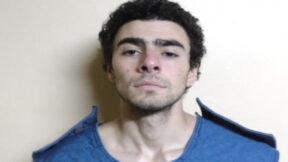New York Times Rejects Viral Claims That Story On Gaza Children Being Shot in the Head is ‘Fabricated’

Brian Zak/Sipa Press via AP
The New York Times responded to viral claims that photos it published of children shot in the head in Gaza were “fabricated.” The images were included in an op-ed that cited dozens of volunteer health care workers who described seeing children shot in the head and chest while serving in Gaza.
Dr. Feroze Sidhwa, a trauma and general surgeon, served for two weeks in Khan Younis, Gaza in March and April. He said he saw more than a dozen children shot in the head during those weeks and he first thought it was the work of a “particularly sadistic soldier” before he heard similar accounts from others.
The volunteer health care workers who spoke with the Times about their experiences described a number of disturbing trends, including young children who are suicidal, suffering from malnutrition, and some who have been shot in the chest or head, many of whom did not survive.
Dr. Sidhwa used the op-ed to call for an end to United States military aid to Israel as the country continues striking Gaza in an attempt to eliminate the Hamas terror group in retaliation for Oct. 7, in which terrorists killed more than 1,000 in Israel and kidnapped hundreds. Israel’s response has killed more than 42,000 people in Gaza since.
In a Tuesday statement, the Times defended their op-ed against claims that photos included in it were “fabricated.”
“A recent opinion essay gathered first-hand testimonies from 65 U.S.-based health professionals who worked in Gaza over the past year, who shared more than 160 photographs and videos with Times Opinion to corroborate their detailed accounts of treating preteen children who were shot in the head or chest. Following publication, some readers questioned the accuracy of the accounts and the authenticity of three CT images shown. Those criticisms are unfounded,” Kathleen Kingsbury, editor of New York Times Opinion, wrote.
Kingsbury said the piece was “rigorously edited.”
She continued:
While our editors have photographs to corroborate the CT scan images, because of their graphic nature, we decided these photos — of children with gunshot wounds to the head or neck — were too horrific for publication. We made a similar decision for the additional 40-plus photographs and videos supplied by the doctors and nurses surveyed that depicted young children with similar gunshot wounds.
We stand behind this essay and the research underpinning it. Any implication that its images are fabricated is simply false.
The x-rays included in the piece were from Dr. Mimi Syed, an emergency doctor from Washington who spent a month in Khan Younis.
“I had multiple pediatric patients, mostly under the age of 12, who were shot in the head or the left side of the chest. Usually, these were single shots. The patients came in either dead or critical, and died shortly after arriving,” the doctor told the Times.
Dr. Sidhwa also posted a lengthy response to criticisms of bias against the piece and the photos in question.
“I’m a trauma surgeon and I’m board certified in neurocritical care, I [treat] people who’ve been shot in the head on a daily basis. I did my residency at the busiest trauma center in New England and my trauma/critical care fellowship at the only level 1 trauma center for all of southern New Jersey, located in the middle of Camden,” he wrote. “I assure you that the CT scout films that Dr. Syed provided in the piece are entirely typical of someone who has been shot in the head but is still alive.”
The “misunderstanding,” the doctor argued, is that critics believe the x-rays are from patients who are dead from a large caliber round.
“That’s something that people commenting don’t seem to understand: if the bullet caused massive cavitation to the point of destroying even the scalp and obliterating a large part of the skull then nobody would call a doctor or get a CT scan for that patient, especially in Gaza, because they’re obviously dead,” he wrote. “They would be sent to the morgue from the emergency department. So, just like in the United States or anywhere else, physicians saw and did investigations on patients whose injuries were life-threatening but who were not obviously dead on arrival.”




